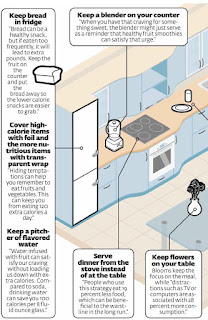Three reasons you need to stop counting calories
I WORK with clients on a daily basis who are so confused by the amount of contradicting information around finding and maintaining a healthy weight.
Over the past few decades there has been a huge emphasis on calorie counting. People measuring each ingredient like a science experiment waiting to explode. The only explosion is usually the frustration that comes with setting yourself up with failure.
The fact is, it’s not practical for most of us, and takes away the enjoyment of food as we are constantly faced with failing our numbers like we are back in school sitting a dreaded maths exam.
For a nutritional plan to work for you, it has to be easy to follow, sustainable and rewarding. Here are three reasons calorie counting should be sent back to the dark ages:
1. THE PROBLEM ISN’T THE AMOUNT OF CALORIES, BUT THE TYPE
Take for example 100 calories from pure sugar compared to 100 calories from avocado. Are they going to be burnt the same way? Will they have the same effect on your hormones such as insulin? Will they create the same cravings and energy low afterwards? Will they stimulate your hormones such as testosterone and oestrogen in a positive way? Are they both used as building blocks to actually build new cells in the body?
The truth is a calorie is not a calorie is not a calorie.
If you understand the effects each type of food has on your body and then you listen to your body, you will have a sustainable way to enjoy eating healthy.
2. IT TAKES AWAY ENJOYMENT
When we set up strict rules and are constantly counting and measuring, it takes away the enjoyment of food. Not to mention that measuring food is not practical unless you are at home with the scales and a calculator. So you set yourself up to fail, especially if you are a social person. No one likes to fail and it kills your sense of achievement and creates unneeded stress.
3. THEY’RE HARD TO ACTUALLY MEASURE
We can measure calories in with hard work, but can we measure calories out precisely? Have you ever been on a treadmill and at the end of a hard one hour run it tells you that you have only burnt off the banana bread you just ate? You freak out and think ‘how much do I have to run to balance everything I am eating in a day?’!
The truth is your body is burning fuel even when you are not moving. Your cells are continually changing, replicating and growing. Your muscles are continually contracting and relaxing even when you are not moving. Take shivering for example.Studies have found that 15 minutes of shivering is equivalent to an hour of moderate exercise.
Also, the more muscle you have the more energy you burn at rest (resting metabolic rate). It is quite impossible to measure your calories burnt unless you are continually hooked up to a respiration monitor.
When it comes to eating healthy, try stick to this method for most meals. Each meal should contain some protein about the size and thickness of your own palm, salad and veggies about the size of your two open hands together and some healthy fats about the size of 2-3 fingers.
This is so much easier than counting calories, but you do need to learn about what are the best sources for your fats/proteins/veggies/carbs etc.






